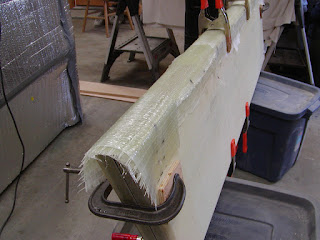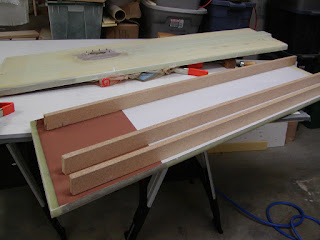I didn't have much time to work on boat stuff earlier this week, but did manage to get the plank grooves bogged and the marine plywood for the keel strip mounted. Then today I laminated the lower hull half. As mentioned before, I am now pre-wetting the foam before I lay the glass down:
 That looks like an awful lot on there, but I found that laying down a thick coat makes the glass wet-out much easier. Here it is all done:
That looks like an awful lot on there, but I found that laying down a thick coat makes the glass wet-out much easier. Here it is all done: I also joined my daggerboard case this weekend on Saturday morning. Here I'm just getting started:
I also joined my daggerboard case this weekend on Saturday morning. Here I'm just getting started:



I brought the daggerboard case inside the house and put it in front of the basement gas fireplace to cure (and turned up the thermostat on the fireplace). Things cure nice and quick this way, although it does heat up the whole house quite a bit (I hope noone asks why the dog is drinking so much water now :)). This meant I had time to do the other side of the case in the same day. Unfortunately I ran out of peelply, which meant that Jay the manly boatbuilder had to accompany his wife to Joanne Fabrics in search of a substitute. The store had no exact replacement, but a light-weight rip-stop nylon seemed to come closest, so I got some of that.
Putting the third layer of glass on the fwd side of the case:
After finishing up the fwd side, I put it in the basement and was expecting to pour the keel insert today. Unfortunately, a huge section of uni and regular BD glass lifted up for some reason:

These pics are getting a bit redundant, but here's one more showing most of the joined case:









5 comments:
I feel sorry for your glass lift on the case. I have experienced this several times (on earlier projects). After I started to use peel ply on everything it seems less likely to occur. I make sure to wet out about an inch of peel ply further than the fabric I am working on. The case and the gudgeons looks great!
Thanks Tor. I did have it peelplyed, but perhaps not far enough past the glass to get good hold-down power -- I'll keep that in mind in future. (Also, my uni glass always seems stiffer than the regular BD knitted glass).
Jay
My uni also is very prone to keeping its original shape (in this case, the curve of the roll it's been on for the past year) - have to REALLY work it and then peel-ply a few inches past it. Also go and check it a few times after it starts to gel and haven't had problems with it now (knock on wood).
Peel-ply is a wonderful invention and I'm going to try and keep using it more and more, esp when we start the center hull.
I've read somewhere on Internet about the "poor man vacuum bag" technique: a thin plastic sheet over the wet glass, INSTEAD of peelply; you remove the air rolling or squegee-ing from center toward the perimeter and then you kept in place by strong adesive tape (you need a dry and clean surface around the wet glass). Sorry for the awkward description, but I hope you get the idea.
You need to sand after curing, before glueing or fairing or painting over. Or maybe you can use peelPly under the plastic sheet. Never tried by myself.
Jay,
I like the artistic night shot of the freshly laminated main half hull.
Post a Comment